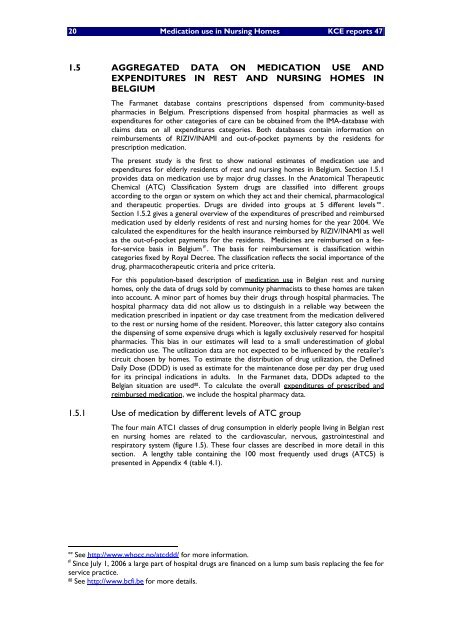Medication use in rest and nursing homes in Belgium. - KCE
Medication use in rest and nursing homes in Belgium. - KCE
Medication use in rest and nursing homes in Belgium. - KCE
Create successful ePaper yourself
Turn your PDF publications into a flip-book with our unique Google optimized e-Paper software.
20 <strong>Medication</strong> <strong>use</strong> <strong>in</strong> Nurs<strong>in</strong>g Homes <strong>KCE</strong> reports 47<br />
1.5 AGGREGATED DATA ON MEDICATION USE AND<br />
EXPENDITURES IN REST AND NURSING HOMES IN<br />
BELGIUM<br />
The Farmanet database conta<strong>in</strong>s prescriptions dispensed from community-based<br />
pharmacies <strong>in</strong> <strong>Belgium</strong>. Prescriptions dispensed from hospital pharmacies as well as<br />
expenditures for other categories of care can be obta<strong>in</strong>ed from the IMA-database with<br />
claims data on all expenditures categories. Both databases conta<strong>in</strong> <strong>in</strong>formation on<br />
reimbursements of RIZIV/INAMI <strong>and</strong> out-of-pocket payments by the residents for<br />
prescription medication.<br />
The present study is the first to show national estimates of medication <strong>use</strong> <strong>and</strong><br />
expenditures for elderly residents of <strong>rest</strong> <strong>and</strong> nurs<strong>in</strong>g <strong>homes</strong> <strong>in</strong> <strong>Belgium</strong>. Section 1.5.1<br />
provides data on medication <strong>use</strong> by major drug classes. In the Anatomical Therapeutic<br />
Chemical (ATC) Classification System drugs are classified <strong>in</strong>to different groups<br />
accord<strong>in</strong>g to the organ or system on which they act <strong>and</strong> their chemical, pharmacological<br />
<strong>and</strong> therapeutic properties. Drugs are divided <strong>in</strong>to groups at 5 different levels ee .<br />
Section 1.5.2 gives a general overview of the expenditures of prescribed <strong>and</strong> reimbursed<br />
medication <strong>use</strong>d by elderly residents of <strong>rest</strong> <strong>and</strong> nurs<strong>in</strong>g <strong>homes</strong> for the year 2004. We<br />
calculated the expenditures for the health <strong>in</strong>surance reimbursed by RIZIV/INAMI as well<br />
as the out-of-pocket payments for the residents. Medic<strong>in</strong>es are reimbursed on a feefor-service<br />
basis <strong>in</strong> <strong>Belgium</strong> ff . The basis for reimbursement is classification with<strong>in</strong><br />
categories fixed by Royal Decree. The classification reflects the social importance of the<br />
drug, pharmacotherapeutic criteria <strong>and</strong> price criteria.<br />
For this population-based description of medication <strong>use</strong> <strong>in</strong> Belgian <strong>rest</strong> <strong>and</strong> nurs<strong>in</strong>g<br />
<strong>homes</strong>, only the data of drugs sold by community pharmacists to these <strong>homes</strong> are taken<br />
<strong>in</strong>to account. A m<strong>in</strong>or part of <strong>homes</strong> buy their drugs through hospital pharmacies. The<br />
hospital pharmacy data did not allow us to dist<strong>in</strong>guish <strong>in</strong> a reliable way between the<br />
medication prescribed <strong>in</strong> <strong>in</strong>patient or day case treatment from the medication delivered<br />
to the <strong>rest</strong> or nurs<strong>in</strong>g home of the resident. Moreover, this latter category also conta<strong>in</strong>s<br />
the dispens<strong>in</strong>g of some expensive drugs which is legally exclusively reserved for hospital<br />
pharmacies. This bias <strong>in</strong> our estimates will lead to a small unde<strong>rest</strong>imation of global<br />
medication <strong>use</strong>. The utilization data are not expected to be <strong>in</strong>fluenced by the retailer s<br />
circuit chosen by <strong>homes</strong>. To estimate the distribution of drug utilization, the Def<strong>in</strong>ed<br />
Daily Dose (DDD) is <strong>use</strong>d as estimate for the ma<strong>in</strong>tenance dose per day per drug <strong>use</strong>d<br />
for its pr<strong>in</strong>cipal <strong>in</strong>dications <strong>in</strong> adults. In the Farmanet data, DDDs adapted to the<br />
Belgian situation are <strong>use</strong>d gg . To calculate the overall expenditures of prescribed <strong>and</strong><br />
reimbursed medication, we <strong>in</strong>clude the hospital pharmacy data.<br />
1.5.1 Use of medication by different levels of ATC group<br />
The four ma<strong>in</strong> ATC1 classes of drug consumption <strong>in</strong> elderly people liv<strong>in</strong>g <strong>in</strong> Belgian <strong>rest</strong><br />
en nurs<strong>in</strong>g <strong>homes</strong> are related to the cardiovascular, nervous, gastro<strong>in</strong>test<strong>in</strong>al <strong>and</strong><br />
respiratory system (figure 1.5). These four classes are described <strong>in</strong> more detail <strong>in</strong> this<br />
section. A lengthy table conta<strong>in</strong><strong>in</strong>g the 100 most frequently <strong>use</strong>d drugs (ATC5) is<br />
presented <strong>in</strong> Appendix 4 (table 4.1).<br />
ee<br />
See http://www.whocc.no/atcddd/ for more <strong>in</strong>formation.<br />
ff<br />
S<strong>in</strong>ce July 1, 2006 a large part of hospital drugs are f<strong>in</strong>anced on a lump sum basis replac<strong>in</strong>g the fee for<br />
service practice.<br />
gg<br />
See http://www.bcfi.be for more details.

















